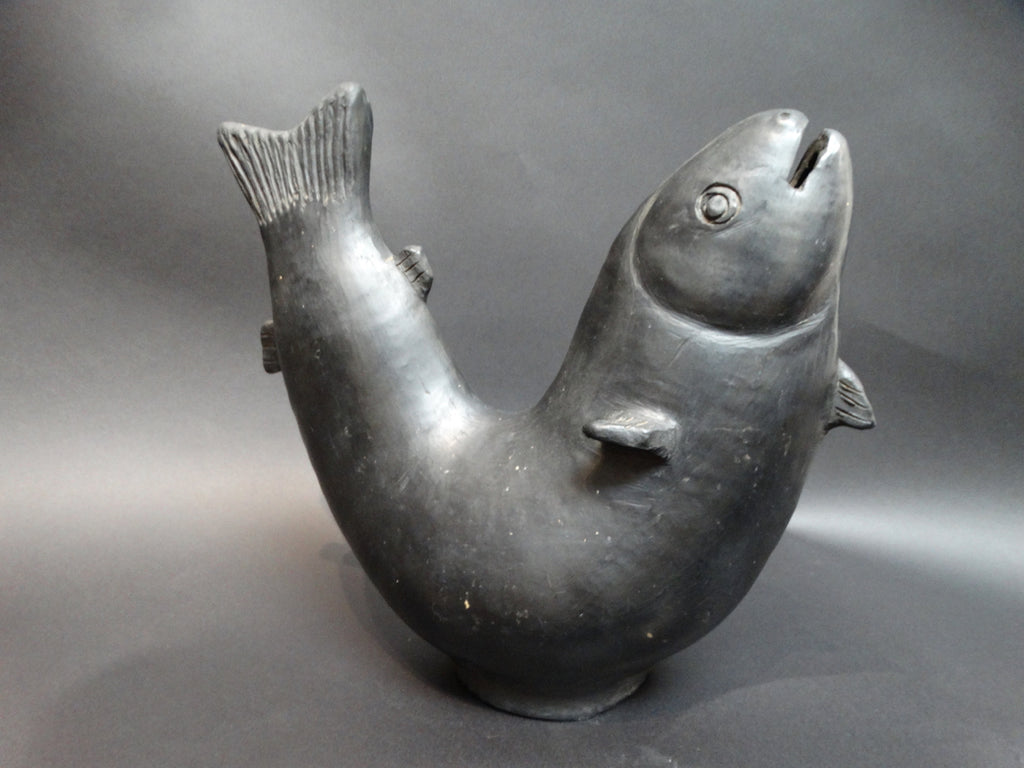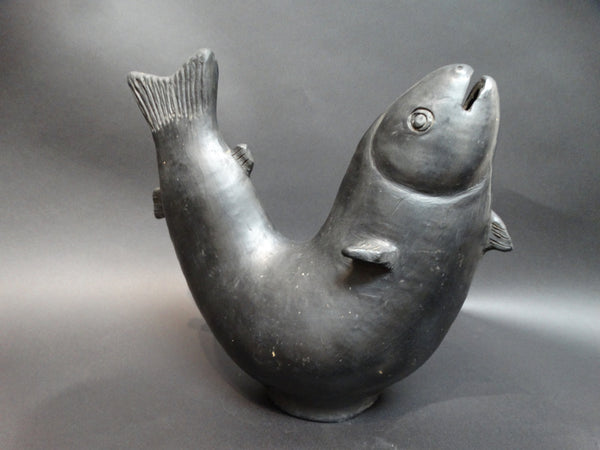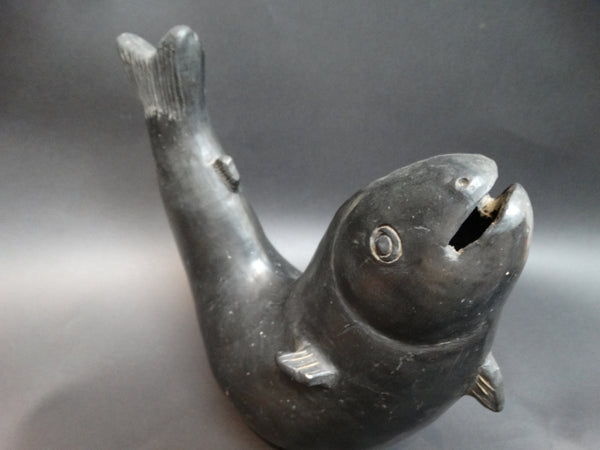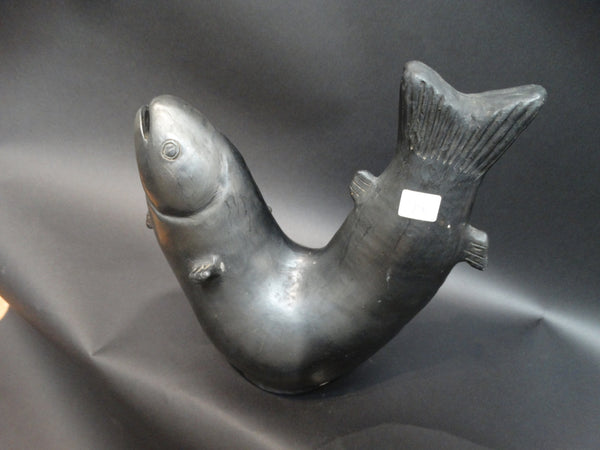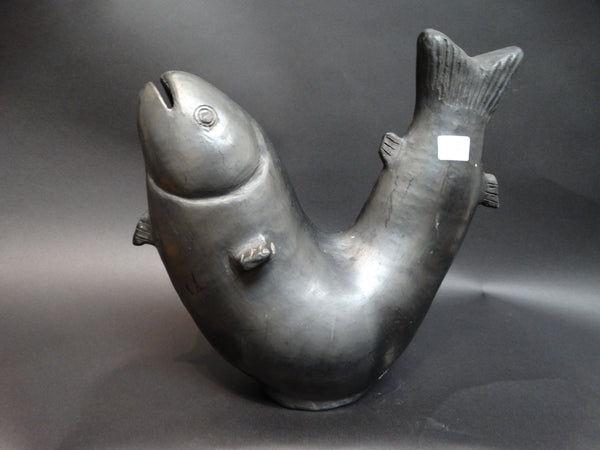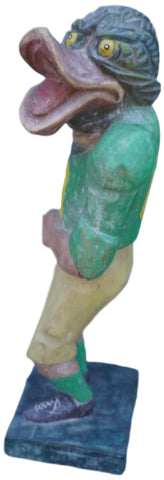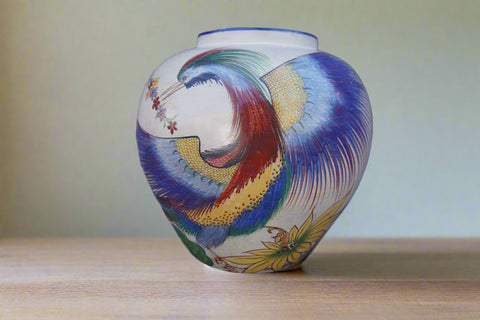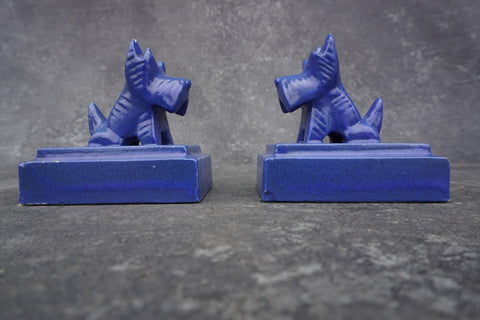Heron Martinez Fish
Heron Martinez Fish Bank - black, 10" x 11" x 5". A superb modernist work.
The work of Herón Martínez Mendoza of Acatlán de Osorio (b.1918-d.1990) has become greatly admired and is sought after by many private collectors, as well as museums. Particularly intriguing about this artist is the fact that although born to the craft, Martínez initially fought his “calling,” but when forced to accept it, he went on to become one of Mexico’s truly exceptional artisans in clay.
Serious collectors like to know the “provenance” of the items they are collecting, and with respect to Martínez’s work, they are fortunate. Although many of the best Mexican craftsmen have died leaving behind little information on their backgrounds and inspirations, Martínez’s early life and work have been documented by Carlos Espejel, former Director of the Museo Nacional de Artes e Industrias Populares in Mexico City, and folk art writers Lenore Mulryan and Louanna Lackey. Since there is a comparative “wealth” of material relating to Martínez’s background and the factors which influenced his creativity, collectors can explore the literature in the attached bibliography which was compiled by David Farmer. It is definitely worth the effort as a fascinating story is to be found.
Phases of Creativity:
As with many craftsmen, Martínez’s work evolved over time. In fact, initially he was reluctant to follow in his family’s footsteps and become a potter. He tried a variety of other lines of work, but nothing came of them, and when he married, he decided to go back to the “family business” of creating things with clay. Starting with utilitarian pieces, he designed a container to carry water, and his design, which prevented the handles from breaking, was so successful that people lined up to buy them.
This success moved him into making pots and planters, and over time, these became more and more creative as he changed their forms to represent animals, fish and various types of birds. As interest in his work grew and folk art stores sought his work, he let his burgeoning creativity loose to make different types of much more complex and sophisticated pieces. (Please note that the phases described below blended into one another. Thus, at times, one could find white/colored pieces along with black clay candle holders, and later alongside burnished pieces. One never knew what one would find in Martínez’s taller.)
White Period:
The earlier work, called by some “the white period,” had a white background made of bisque ware and covered with a coat of gesso “blanco” – a chalky looking plaster. These white slip bases were often decorated with acrylic paints in vivid colors, with much of the painting done by Martínez’s wife, Olivia. The choice of materials was very wise as years later, the white retains its clarity, and the colors remain bright. Many of the early trees of life and candelabra were quite large, and although seemingly fragile, a surprising number of them have survived well.
This early work has become particularly collectible. Martínez’s fantastic imagination is evident in the widely varied pieces produced during this period. He seemed to be influenced by everything he saw. He even admitted that his dreams were sources of inspiration. He also commented that his trees of life with religious themes were inspired after viewing religious stamps in an album owned by one of his wife’s relatives. Some of the designs prized by collectors include nativity scenes, the Virgin of Guadalupe, Adam and Eve, the flight into Egypt, and altar pieces for the Day of Kings. Non-religious themes include circus figures, such as trapeze artists stacked on one another’s backs, stacked animals and also charming figures of people holding jugs, animals and birds. Some of the more elaborate pieces are decorated on both sides so they can be used as centerpieces. This “white period” clearly was one of the pinnacles of Martínez’s work.
Burnished Period:
The 1950s brought another source of inspiration which was to last for the rest of Martínez’s life. Archaeologists visited the area to do excavations. They found numerous clay shards, which had been highly burnished and imprinted with pre-Hispanic designs. Martínez was very taken with the burnished look of the clay and sought out a potter in the area who was one of the last to know how to give clay the burnished look he admired. He learned the skill, and his work became distinguished by a rich brown The sheen (almost a cinnamon color). He added pre-Hispanic motifs, which included patterns and designs of the glyphs and step frets found by the archaeologists. His array of forms using the rich brown color and angular patterns was phenomenal–every kind of animal, bird, person, and fish was transformed into whimsical candelabras and planters. Walking into his studio with all the different kinds of creatures conjured up by Martínez was like going into a land of clay fantasy.
Ceramic pieces out of black clay pottery were also produced in Martínez’s taller (probably the 1950s up to the 1970s. These resembled those produced in Coyotepec, Oaxaca. According to author James Norman, unlike the Coyotepec pottery, which gets its rich metallic black color from kiln-smudging and hand burnishing, the pieces produced in Acatlán were given a black slip.
While it has become more difficult to find the pieces from earlier periods (including the painted figures and large trees of life), it is easier to find smaller pieces from the burnished period. These run the gamut from pots, wall plaques, and churches to zoomorphic pieces (“animales fantasticos” or “animales grotéscos”). For the most part, the latter took the form of candelabros (candle holders) which have a central animal figure for support. Mounted on these are other creatures, sometimes forming pyramid shapes. Lizards, birds, octopi, armadillos, horses, giraffes, dinosaurs and even rodents are among the fanciful depictions. Just about any creature in the animal or bird kingdoms was “fair game” for Martínez’s boundless imagination.
Bio courtesy of Lee Price Arellano. (Use of the bio info from heronmartinez.com does not presume authentication from Lee Price Arellano, however, Early California Antiques has had the items authenticated by Mexican Folk Art experts in L.A. and Santa Fe.)

